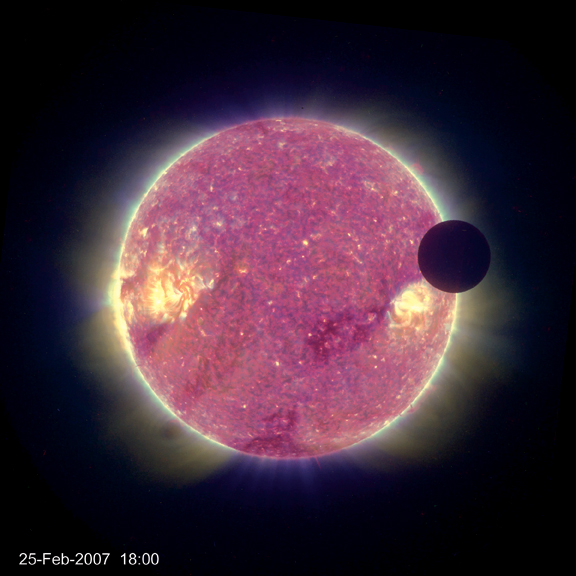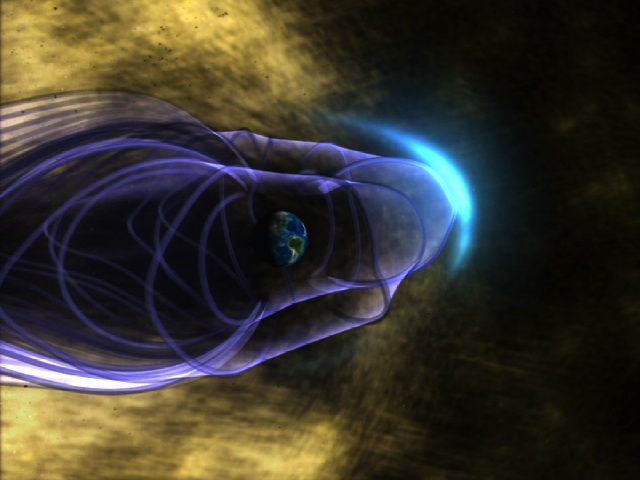Moon & Sun Interact in Surprising Way

A stream of charged particles called the solar wind blows through space constantly at about a million miles an hour. Earth’s magnetic field creates a bubble that protects the planet from most of these particles, and on Earth’s day side a bow shock is created that is tends of thousands of miles across. Scientists didn’t think the moon interacted with the solar wind in this manner, but new research finds it does, albeit in more subtle fashion.
The moon does not have a global magnetic field, so scientists didn’t expect a bow shock or any other interaction with the solar wind other than the lunar surface being bombarded by the charged particles. "It was thought that the solar wind crashes into the lunar surface without any warning or 'push back' on the solar wind," explains Andrew Poppe of the University of California, Berkeley.
Now an international fleet of lunar-orbiting spacecraft has detected signs of the moon's presence "upstream" in the solar wind.
"We've seen electron beams and ion fountains over the moon's day side," says Dr. Jasper Halekas, also of the University of California, Berkeley.
These phenomena have been seen as far as 10,000 kilometers (6,214 miles) above the moon and generate a kind of turbulence in the solar wind ahead of the moon, causing subtle changes in the solar wind's direction and density.
The electron beams were first seen by NASA's Lunar Prospector mission, while the Japanese Kaguya mission, the Chinese Chang'e mission, and the Indian Chandrayaan mission all saw ion plumes at low altitudes. NASA's ARTEMIS mission has now also seen both the electron beams and the ion plumes, plus newly identified electromagnetic and electrostatic waves in the plasma ahead of the moon, at much greater distances from the moon, the researchers said in a statement.
"With ARTEMIS, we can see the plasma ring and wiggle a bit, surprisingly far away from the moon," Halekas said.
Get the Space.com Newsletter
Breaking space news, the latest updates on rocket launches, skywatching events and more!

"An upstream turbulent region called the 'foreshock' has long been known to exist ahead of the Earth's bow shock, but the discovery of a similar turbulent layer at the moon is a surprise," said study team member William Farrell of NASA's Goddard Space Flight Center.
What’s going on?
Computer simulations reveal a complex electric field near the lunar surface is generated by sunlight and the flow of the solar wind. The simulation reveals this electric field can generate electron beams by accelerating electrons blasted from surface material by solar ultraviolet light. Also, related simulations show that when ions in the solar wind collide with ancient, "fossil" magnetic fields in certain areas on the lunar surface, they are reflected back into space in a diffuse, fountain-shaped pattern. These ions are mostly the positively charged ions (protons) of hydrogen atoms, the most common element in the solar wind.
"It's remarkable that electric and magnetic fields within just a few meters (yards) of the lunar surface can cause the turbulence we see thousands of kilometers away," Poppe said.
Asteroids and other moons might create similar phenomena, the researchers figure. The research is detailed in a series of papers in Geophysical Research Letters and the Journal of Geophysical Research.
Join our Space Forums to keep talking space on the latest missions, night sky and more! And if you have a news tip, correction or comment, let us know at: community@space.com.

Space.com is the premier source of space exploration, innovation and astronomy news, chronicling (and celebrating) humanity's ongoing expansion across the final frontier. Originally founded in 1999, Space.com is, and always has been, the passion of writers and editors who are space fans and also trained journalists. Our current news team consists of Editor-in-Chief Tariq Malik; Editor Hanneke Weitering, Senior Space Writer Mike Wall; Senior Writer Meghan Bartels; Senior Writer Chelsea Gohd, Senior Writer Tereza Pultarova and Staff Writer Alexander Cox, focusing on e-commerce. Senior Producer Steve Spaleta oversees our space videos, with Diana Whitcroft as our Social Media Editor.









